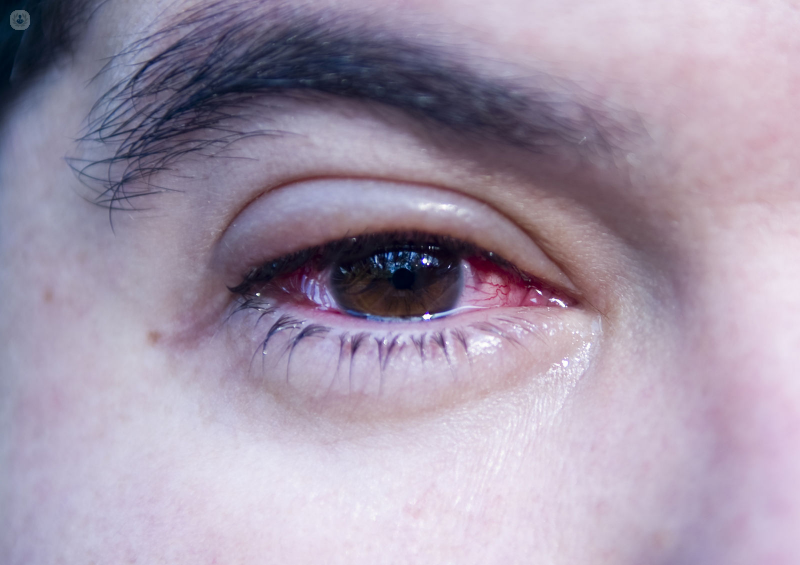

What is conjunctivitis?
Conjunctivitis is the inflammation of the conjunctiva, the mucosa that lines the layers of the eyelids, the front face of the eyeball. Its basic function is to protect the surfaces it covers, so when an infection occurs on them, it becomes inflamed.
The main types of conjunctivitis, depending on their cause, are:
- Viral conjunctivitis
- Bacterial conjunctivitis
- Allergic conjunctivitis
Conjunctivitis generally does not affect vision. Infectious conjunctivitis is easily spread from person to person.

Prognosis:
It usually affects both eyes at the same time, although it can affect one eye more than the other. It will usually last about 10 days to 4 weeks and is a very common disorder, especially in children, including new-borns.
Symptoms of conjunctivitis:
The most common symptoms of conjunctivitis are:
- Redness
- Burning
- Itchiness
- Appearance of yellow or green mucous, especially in the eyelashes.
Medical tests for conjunctivitis:
To determine if a patient has conjunctivitis, the doctor will examine the eyes for signs of conjunctivitis.
Some specific tests that may be performed are:
- Tear drainage analysis
- Assessment of visual acuity
What causes conjunctivitis?
The causes may be:
- Viral infection: causes viral conjunctivitis, is very contagious, but usually disappears on its own within a few days, without the need for medical treatment.
- Bacterial infection: causes bacterial conjunctivitis, which can cause serious damage to the eye if left untreated.
- Allergies: causes allergic conjunctivitis, which is caused by eye irritants such as pollen or dust in susceptible individuals. This type of conjunctivitis can be seasonal (pollen) or appear in outbreaks throughout the year (dust and pet fur).
- Substances that cause irritation.
- Products used for contact lenses, eye drops or ointments that have been contaminated.
Can conjunctivitis be prevented?
Simple preventive measures can be taken on a day-to-day basis to significantly reduce the risk of getting conjunctivitis:
- Do not share personal hygiene items such as cloths and hand towels.
- Cover your nose and mouth when coughing and sneezing, and avoid rubbing or touching your eyes.
- Never share contact lenses.
- Wash your hands often.
- Keep surfaces clean, such as kitchen tables, bathroom utensils, taps and shared telephones with an appropriate antiseptic cleaner.
- If you have seasonal allergies, ask your doctor what you can do to minimise your symptoms before they start.
- If you wear contact lenses, you should make sure you follow the advice of your optometrist or ophthalmologist for their care and replacement.
- To go swimming, use swimming goggles to protect your eyes from bacteria or other microorganisms in the water that can cause conjunctivitis.
- Remove contact lenses to avoid retaining bacteria between your eyes and your lenses before showering, using a hot tub or getting into water of any kind.
Treatments for conjunctivitis:
Depending on the type of conjunctivitis, the following treatments might be needed:
- Viral conjunctivitis: In most cases, viral conjunctivitis will run its course within a few days without medical treatment. A home remedy is to apply cold wet wipes to the eyes several times a day to relieve symptoms. It is important not to share wipes, as viral conjunctivitis is highly contagious.
- Bacterial conjunctivitis: Antibiotic eye drops or ointments will usually be prescribed to treat this type of conjunctivitis.
- Allergic conjunctivitis: Anti-allergy medications often help prevent or shorten outbreaks of allergic conjunctivitis.
Which specialist treats conjunctivitis?
Ophthalmologists are in charge of preventing, diagnosing and treating diseases that affect the eyes and the visual capacity of the patient, such as conjunctivitis.
